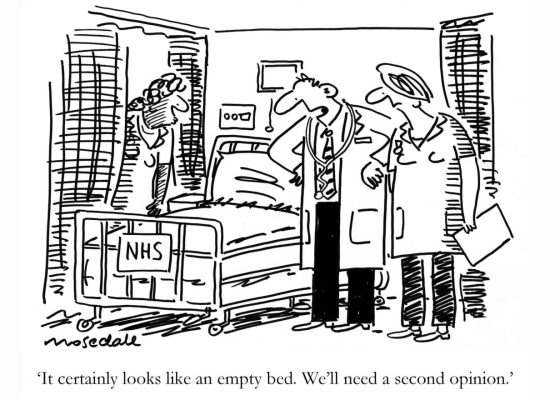The massive potential of virtual care to reduce our hospital patient burden and improve overall system ROI is about to hit a digital infrastructure ceiling. We could push through it if governments organise better on existing state initiatives.
One (of a few) well-run projects producing a detailed, evolving evidence base to map how we can scale hospital virtual care provision faster to increase overall system return on investment is the Victorian Virtual ED program.
The program had its origins at the Northern Hospital in Melbourne in 2020 as a tactical response to the covid pandemic with a goal of diverting low-acuity covid patients from overloaded emergency departments and managing them at home.
The results were so good on the program that the idea of expanding to diverting as many low-acuity patients as possible became obvious. In 2021 the service started working with ambulances and in April 2022 the Victorian government block-funded the project to begin expansion across the whole of Victoria.
The idea behind VVED and other hospital virtual programs in other states starting to prove good ROI is simple: divert patients with non-life-threatening conditions away from the physical ED to reduce overcrowding and increase efficiency. And, depending on how well that goes, expand your virtual model outwards to non-ED services, especially in the regions for in- and outpatient services.
The VVED provides access to emergency medical staff virtually and a direct consultation pathway for downstream providers such as GPs, aged care nurses and paramedics.
What is particularly exciting about VVED and other state-based virtual care programs like it is that the idea naturally lends itself to scale.
What worked in Northern Hospital in Melbourne quickly expanded to the whole Northern Health catchment and now to the whole state. A bit like how Healthdirect is evolving, with some good funding and data, it’s not a huge jump to see it as a national service with doctors working with it all over the country, and even overseas.
Despite VVED having a higher degree of difficulty in organising a statewide centralised offering because of the more eclectic hospital management paradigm in Victoria, the ROI has been good and Victoria is committed to expanding the program, albeit the funding is one-off for a set period each time the program gets it – so it’s not forever, yet.
But there’s a big problem on the horizon for all these state-based hospital virtual care programs.
The growing evidence base is pointing to a big near-term scaling issue – a potential ROI ceiling.
That’s because until now, most of the ROI achieved in these programs has been through the clever application of workforce, not technology so much, which sounds counterintuitive.
As the project leaders map out expansion and scale of their programs, two things are becoming clearer in their data points: they are going to run out of the workforce needed to keep scaling (this is already an issue), and, scaling workforce in the main, starts to become very inefficient at a point, anyway.
In other words, many of our high-potential hospital virtual care projects have achieved a lot of their ROI so far through the application of workforce and reasonably basic virtual care technology which, because of the still disconnected nature of our digital platforms for various providers, remains reasonably disconnected.
Unbeknownst to most system observers, the workforce card, which was the natural first step in any hospital virtual care project, and vital, has now largely been played.
A lot of these projects may seem magically virtual to an outsider, but if you lift the lid on how they are getting things done, under the waterline there are a lot of human ducks furiously paddling to keep things moving. More automation is needed, and soon.
Clinical dDirector of the VVED, Dr Loren Sher, explains the problem this way:
“The issue is that to date, we’ve accommodated a lot of the inefficiencies with staffing.
“We’ve found all the innovative ways to accommodate digital inefficiency using staff, but eventually we will run out of staff.
“We will get to point where [the problem is] just so big that there will not be enough staff to accommodate the level of complexity.
“At this point we need a digital uplift: things like AI digital tools to screen our patients for us and more sophisticated integrations to outside platforms.”
Dr Sher uses aged care as an important example of the evolving problem.
“[Today] we cannot access information about patients in aged care and their medical histories so we’ve hired ‘clinical assistants’ [often medical students] to go in and take all the history and boilerplate all that information,” she said.
“When the actual geriatrician or emergency physician goes in [on the virtual system], that information is ready and available for them.
“But there’s a human resource that we are hiring to go and gain that information, and they still don’t know if it’s 100% correct, because we can’t access the digital systems that have it at this point of time.”
The vital next step is more sophisticated and enabling technology integration, says Dr Sher
Who, other than the state-based program managers are understanding this problem, and who is going to fund overcoming it?
So far, nearly all the virtual care projects across the states have been grant-funded in a block manner because, while the ROI potential is obvious, and being proven out so far, hospital funding settings don’t support building out virtual care infrastructure.
Hospital funding not following virtual care is a separate but important problem.
For this story read simply that the federal and state governments are currently hugely distracted by the NDIS vs the NHRA, so realising that a couple of tactical tweaks need to be included in the National Health Reform Agreement to address better incentives for the states to fund hospital virtual care programs isn’t exactly front of mind.
Because all the virtual care programs are occurring state by state in isolation from each other, and each state is obsessed with the basic money negotiation on the NHRA, no state government has yet given serious thought to funding the digital infrastructure needs of the any hospital virtual care trials to date.
From a political standpoint – which you have to start with – it’s almost understandable why.
Everyone is stretched to breaking point. The NHRA negotiations are tough for everyone, more so now than ever because the NDIS funding is confusing the picture significantly, and the pollies are worried that they aren’t even going to get enough in any new deal to even do the basics.
Higher-level forward thinking on ROI and digital development for hospital virtual care projects, which will very likely not be seen clearly within one political cycle, isn’t likely to occur spontaneously in this febrile environment.
It should, of course.
Related
The opportunity for system ROI from better digital integration of hospital based virtual care services is one of the most important emerging pivot points for overall system transformation moving forward.
Says Dr Sher:
“The digital tools exist to solve all or most of our problems. The issue is the funding and willingness to invest in these things.
“The reality is, we’ve demonstrated return on our investment, trying to convince the people with the money, who are really struggling with their budgets already, that that return should be reinvested back into tech, is really tricky.
“We now need upfront investment in the digital tools that can solve all our problems, and ongoing investment to keep it up to date.”
As things stand, no one is stepping up to own the problem. No one seems to be even talking about it.
The danger with such a situation is that all the fragmented block-funding arrangements for hospital-based virtual care start to break down over time not long after we hit the ROI and productivity ceiling that the virtual care program leaders are warning us we are approaching.
If we allow these programs to hit this ceiling and we stall or start to defund them, this could easily end up as one of our biggest system design mistakes since we decided to double down on the My Health Record with its opt-out project.
Other countries overseas have punched through the digital disablement barrier on hospital virtual care and proven that scaled virtual care offers the system a natural significant next step up in system ROI.
Someone needs to own the problem. Who though?
“I think there would be a real power in having a national vision for digital health and a national body helping to drive some of this investment,” says Dr Sher.
While there are some important differences in how each state can roll out virtual care programs because of issues of policy and even regional demographics, the basics of virtual integration will mostly be shared between every program.
Allowing each state to build out their own integration technology would be a huge opportunity missed for a few reasons:
- Funding needs to be optimised and focused, but if each state went their own way there would be repetition and waste, and the ability to share across state borders when needed would likely add yet another complexity to system sharing;
- The digital integration problems for virtual care programs out of hospitals would dovetail naturally into other national digital infrastructure data-sharing projects, notably the national HIE, and the atomisation of the My Health Record via FHIR;
- The states are already starting to see the benefits of digital alignment and are actively participating in digital alignment projects such as Sparked. It would be easier than usual to co-ordinate participation in such a project;
- National digital infrastructure alignment is already in play with things like Healthdirect, the national HIE, Sparked and the My Health Record. Co-ordination is key with all of this stuff;
- The opportunity for system ROI in hospital virtual care, if facilitated by state and federal co-ordination, might be one of the biggest system opportunities in decades because what works in one region is starting to work across states and what works in one state or territory will work in the rest. It’s the scalable opportunity for the system;
- The work would not only create hospital system ROI it would almost certainly lead to downstream ROI by helping meet the primary care system in the middle with hospital to primary care connectivity. The DoHDA is doing a lot of work to make primary care accessible to hospitals. Why wouldn’t DoHDA take on some work to meet primary care from the other end of the spectrum?
When you consider the huge amount of co-ordination and alignment that the ADHA is now attempting with projects like the upgraded My Health Record, the national HIE, Sparked and other “sharing by default” programs, and the amount of funding dedicated to each of these key projects, it feels sensible that something should be both funded and co-ordinated at the national level for the work being done with each of our so far state-funded hospital virtual care programs.
It would or should, of course, all be in a very close co-design set up with each state group building out these capabilities.
The obvious next problem is: where does the money come from?
Most of the ADHA projects are accounted for in forward estimates, and DoDHA is spending a lot already on things like the new bulk-billing incentives.
Given the confusion in co-joining NDIS funding problems to the NHRA, making an argument – which would be a good one – that between every state and territory they make some contribution from the NHRA because it would cost them a lot less overall in time, is unlikely to fly.
In part because as things stand most states and territories are only committed to ongoing funding of their virtual care programs at current levels, not at the amounts needed to build out the now much-needed digital infrastructure components.
If we assume no one is going to go in to bat for extra money for this at the state and federal level then what it comes down to is – what is the ROI of funding the virtual care programs to break through the ceiling they are identifying, versus other projects we are funding. That would be both at the state and federal level.
An inexpensive starting point might be to form some sort of project structure that has everyone at the table analysing and organising the problem so the opportunity doesn’t get away from us any longer — maybe a subset group reporting to the Council of Australian Governments (COAG) Health Council.
Whatever we do, we’d better do something, and quick.
Dr Sher will be discussing the problem at the New Models of Care Shaping the Future of Hospitals Summit in Sydney on October 16 on an expert panel looking at where we can identify sweet spots in the convergence of new models of care, technology trends and funding. The panel will also be featuring Associate Professor Annie Lau, Health Informatics Researcher, Macquarie University, Dr David Hansen, CEO and Research Director, CSIRO’s Australian e-Health Research Centred Travis Grant, Managing Director, Australia Health, Accenture. If you want to come, you can find the full program and still get a ticket HERE.
The summit will also be looking at the latest in cloud, AI and virtual care technologies that are being adapted to help hospitals innovate for more efficiency at speed.
If you’d like a ticket you can get a 20% discount on all ticket types HERE.
The full program and speaker line-up is HERE.
If you have any questions, contact greta@healthservicesdaily.com.au.




